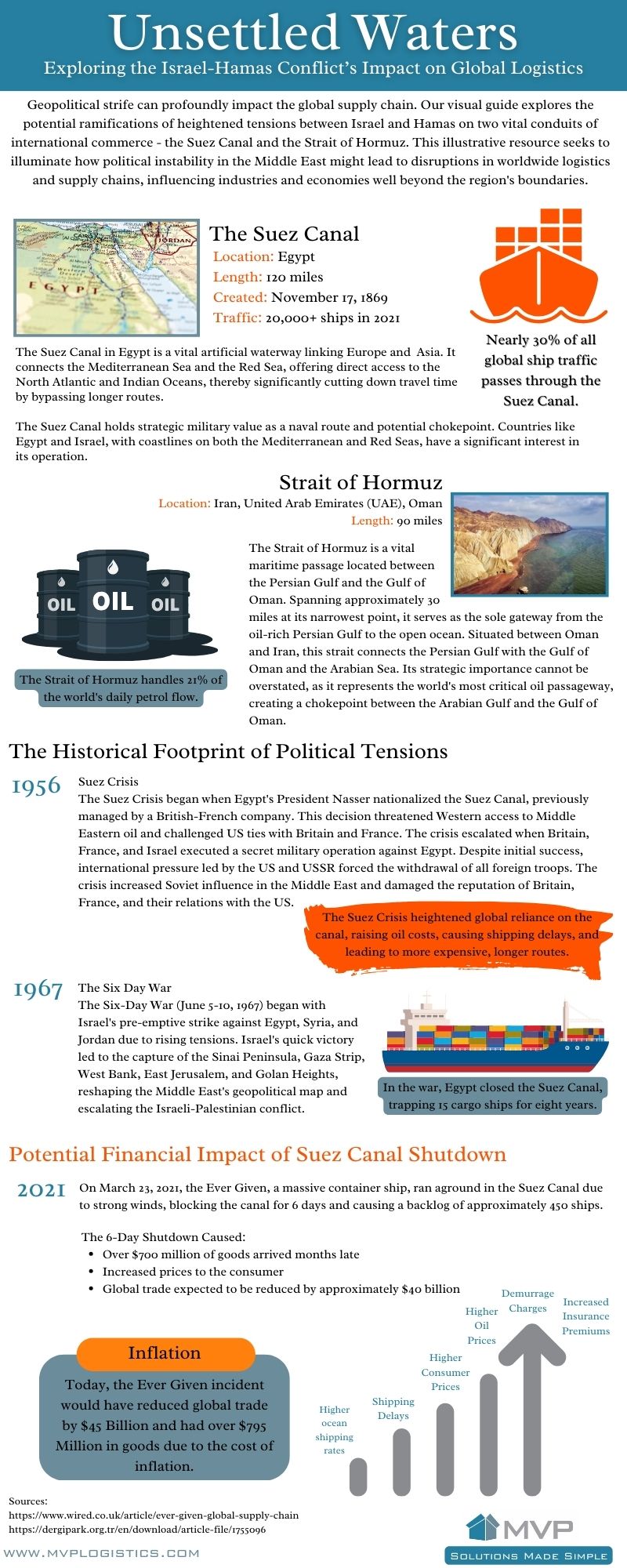Geopolitical strife can profoundly impact the global supply chain. Our visual guide explores the potential ramifications of heightened tensions between Israel and Hamas on two vital conduits of international commerce – the Suez Canal and the Strait of Hormuz. This illustrative resource seeks to illuminate how political instability in the Middle East might lead to disruptions in worldwide logistics and supply chains, influencing industries and economies well beyond the region’s boundaries.
The Suez Canal
Location: Egypt
Length: 120 miles
Created: November 17, 1869
Traffic: 20,000+ ships in 2021
The Suez Canal in Egypt is a vital artificial waterway linking Europe and Asia.
It connects the Mediterranean Sea and the Red Sea, offering direct access to the North Atlantic and Indian Oceans, thereby significantly cutting down travel time by bypassing longer routes.
The Suez Canal holds strategic military value as a naval route and potential chokepoint. Countries like Egypt and Israel, with coastlines on both the Mediterranean and Red Seas, have a significant interest in its operation.
Fact: Nearly 30% of all global ship traffic passes through the Suez Canal
Strait of Hormuz
Location: Iran, United Arab Emirates (UAE), Oman
Length: 90 miles
The Strait of Hormuz is a vital maritime passage located between the Persian Gulf and the Gulf of Oman.
Spanning approximately 30 miles at its narrowest point, it serves as the sole gateway from the oil-rich Persian Gulf to the open ocean.
Situated between Oman and Iran, this strait connects the Persian Gulf with the Gulf of Oman and the Arabian Sea.
Its strategic importance cannot be overstated, as it represents the world’s most critical oil passageway, creating a chokepoint between the Arabian Gulf and the Gulf of Oman.
Fact: The Strait of Hormuz handles 21% of the world’s daily petrol flow
The 1956 Suez Crisis
The Suez Crisis began when Egypt’s President Nasser nationalized the Suez Canal, previously managed by a British-French company. This decision threatened Western access to Middle Eastern oil and challenged US ties with Britain and France.
The crisis escalated when Britain, France, and Israel executed a secret military operation against Egypt.
Despite initial success, international pressure led by the US and USSR forced the withdrawal of all foreign troops.
The crisis increased Soviet influence in the Middle East and damaged the reputation of Britain, France, and their relations with the US.
Fact: The Suez Crisis heightened global reliance on the canal, raising oil costs, causing shipping delays, and leading to more expensive, longer routes.

The 1967 Six Day War
The Six-Day War (June 5-10, 1967) began with Israel’s pre-emptive strike against Egypt, Syria, and Jordan due to rising tensions.
Israel’s quick victory led to the capture of the Sinai Peninsula, Gaza Strip, West Bank, East Jerusalem, and Golan Heights, reshaping the Middle East’s geopolitical map and escalating the Israeli-Palestinian conflict.
Fact: In the war, Egypt closed the Suez Canal, trapping 15 cargo ships for eight years!
Potential Financial Impact of Suez Canal Shutdown
On March 23, 2021, the Ever Given, a massive container ship, ran aground in the Suez Canal due to strong winds, blocking the canal for 6 days and causing a backlog of approximately 450 ships.
The 6-Day shutdown caused:
- Over $700 million of goods arrived months late
- Increased prices to the consumer
- Global trade expected to be reduced by approximately $40 billion
Fact: Today, the Ever Given incident would have reduced global trade by $45 billion and had over $795 million in goods due to the cost of inflation
If the political conflict continues to escalate you can expect to see:
- Higher ocean shipping rates
- Shipping delays
- Higher consumer prices
- Higher oil prices
- Demurrage charges
- Increased insurance premiums
Sources:
